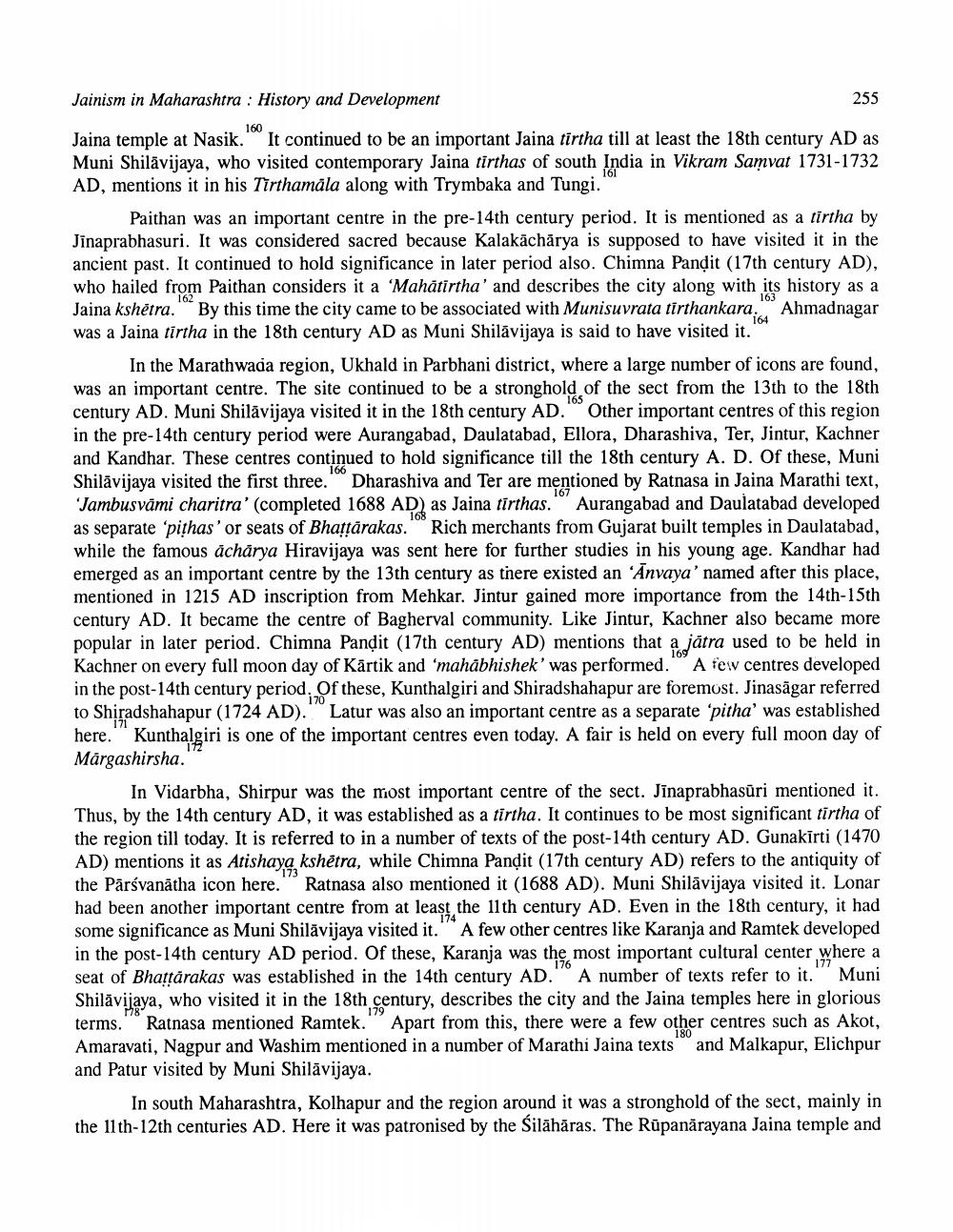________________
Jainism in Maharashtra : History and Development
160
Jaina temple at Nasik. It continued to be an important Jaina tirtha till at least the 18th century AD as Muni Shilāvijaya, who visited contemporary Jaina tirthas of south India in Vikram Samvat 1731-1732 AD, mentions it in his Tirthamala along with Trymbaka and Tungi.
161
255
Paithan was an important centre in the pre-14th century period. It is mentioned as a tirtha by Jinaprabhasuri. It was considered sacred because Kalakacharya is supposed to have visited it in the ancient past. It continued to hold significance in later period also. Chimna Pandit (17th century AD), who hailed from Paithan considers it a 'Mahātirtha' and describes the city along with its history as a Jaina kshetra. By this time the city came to be associated with Munisuvrata tirthankara, Ahmadnagar was a Jaina tīrtha in the 18th century AD as Muni Shilāvijaya is said to have visited it.
162
163
164
166
167
168
In the Marathwada region, Ukhald in Parbhani district, where a large number of icons are found, was an important centre. The site continued to be a stronghold of the sect from the 13th to the 18th century AD. Muni Shilavijaya visited it in the 18th century AD. Other important centres of this region in the pre-14th century period were Aurangabad, Daulatabad, Ellora, Dharashiva, Ter, Jintur, Kachner and Kandhar. These centres continued to hold significance till the 18th century A. D. Of these, Muni Shilavijaya visited the first three." Dharashiva and Ter are mentioned by Ratnasa in Jaina Marathi text, Jambusvāmi charitra' (completed 1688 AD) as Jaina tīrthas. Aurangabad and Daulatabad developed as separate 'pithas' or seats of Bhaṭṭārakas. Rich merchants from Gujarat built temples in Daulatabad, while the famous acharya Hiravijaya was sent here for further studies in his young age. Kandhar had emerged as an important centre by the 13th century as there existed an 'Anvaya' named after this place, mentioned in 1215 AD inscription from Mehkar. Jintur gained more importance from the 14th-15th century AD. It became the centre of Bagherval community. Like Jintur, Kachner also became more popular in later period. Chimna Pandit (17th century AD) mentions that a jatra used to be held in Kachner on every full moon day of Kartik and 'mahābhishek' was performed. A few centres developed in the post-14th century period, Of these, Kunthalgiri and Shiradshahapur are foremost. Jinasägar referred to Shiradshahapur (1724 AD). Latur was also an important centre as a separate 'pitha' was established here. Kunthalgiri is one of the important centres even today. A fair is held on every full moon day of Margashirsha.
170
173
In Vidarbha, Shirpur was the most important centre of the sect. Jinaprabhasüri mentioned it. Thus, by the 14th century AD, it was established as a tirtha. It continues to be most significant tirtha of the region till today. It is referred to in a number of texts of the post-14th century AD. Gunakirti (1470 AD) mentions it as Atishaya kshetra, while Chimna Pandit (17th century AD) refers to the antiquity of the Parsvanatha icon here. Ratnasa also mentioned it (1688 AD). Muni Shilāvijaya visited it. Lonar had been another important centre from at least the 11th century AD. Even in the 18th century, it had some significance as Muni Shilāvijaya visited it. A few other centres like Karanja and Ramtek developed in the post-14th century AD period. Of these, Karanja was the most important cultural center where a seat of Bhaṭṭārakas was established in the 14th century AD. A number of texts refer to it. Muni Shilāvijaya, who visited it in the 18th century, describes the city and the Jaina temples here in glorious terms. Ratnasa mentioned Ramtek. Apart from this, there were a few other centres such as Akot, Amaravati, Nagpur and Washim mentioned in a number of Marathi Jaina texts and Malkapur, Elichpur
174
176
177
and Patur visited by Muni Shilāvijaya.
In south Maharashtra, Kolhapur and the region around it was a stronghold of the sect, mainly in the 11th-12th centuries AD. Here it was patronised by the Silähäras. The Rūpanarayana Jaina temple and




